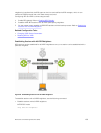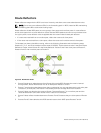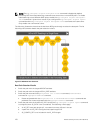
8
Border Gateway Protocol IPv4 (BGPv4)
This chapter provides a general description of BGPv4 as it is supported in the Dell Networking Operating
System (OS).
BGP protocol standards are listed in the Standards Compliance chapter.
BGP is an external gateway protocol that transmits interdomain routing information within and between
autonomous systems (AS). The primary function of the BGP is to exchange network reachability
information with other BGP systems. BGP generally operates with an internal gateway protocol (IGP) such
as open shortest path first (OSPF) or router information protocol (RIP), allowing you to communicate to
external ASs smoothly. BGP adds reliability to network connections by having multiple paths from one
router to another.
Autonomous Systems (AS)
BGP autonomous systems (ASs) are a collection of nodes under common administration with common
network routing policies.
Each AS has a number, which an internet authority already assigns. You do not assign the BGP number.
AS numbers (ASNs) are important because the ASN uniquely identifies each network on the internet. The
Internet Assigned Numbers Authority (IANA) has reserved AS numbers 64512 through 65534 to be used
for private purposes. IANA reserves ASNs 0 and 65535 and must not be used in a live environment.
You can group autonomous systems into three categories (multihomed, stub, and transit), defined by
their connections and operation.
• multihomed AS — is one that maintains connections to more than one other AS. This group allows
the AS to remain connected to the Internet in the event of a complete failure of one of their
connections. However, this type of AS does not allow traffic from one AS to pass through on its way
to another AS. A simple example of this group is seen in the following illustration.
• stub AS — is one that is connected to only one other AS.
• transit AS — is one that provides connections through itself to separate networks. For example, in the
following illustration, Router 1 can use Router 2 (the transit AS) to connect to Router 4. Internet
service providers (ISPs) are always transit ASs, because they provide connections from one network to
another. The ISP is considered to be “selling transit service” to the customer network, so thus the term
Transit AS.
When BGP operates inside an AS (AS1 or AS2, as seen in the following illustration), it is referred to as
Internal BGP (IBGP Internal Border Gateway Protocol). When BGP operates between ASs (AS1 and AS2), it
is called External BGP (EBGP External Border Gateway Protocol). IBGP provides routers inside the AS with
the knowledge to reach routers external to the AS. EBGP routers exchange information with other EBGP
routers as well as IBGP routers to maintain connectivity and accessibility.
164
Border Gateway Protocol IPv4 (BGPv4)


















